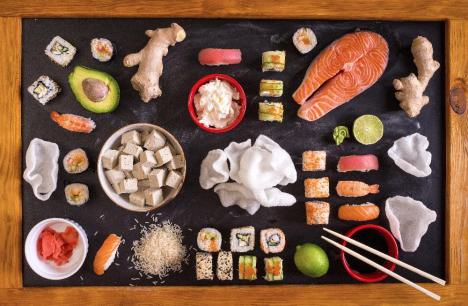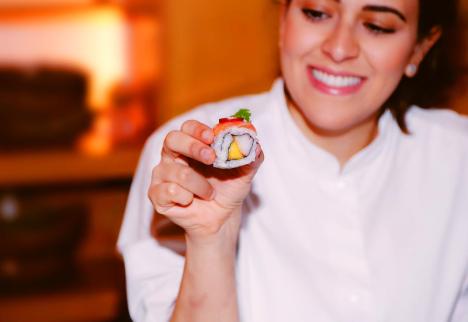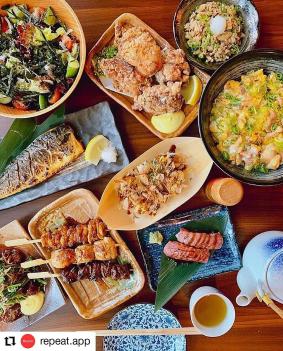





Hala Tashkandi Jeddah
There’s no two ways about it: Saudi Arabia loves Japanese food.
Be it sushi or tempura, ramen or teriyaki, you name it, Saudis love it, and are here for it.
From the deep-fried and totally inauthentic sushi rolls to the most delicate cuts of ootoro and salmon sashimi, you can find them all in the Kingdom.
Despite the popularity of Japanese cuisine, the availability of original ingredients in Saudi markets is sorely lacking, forcing Japanese food enthusiasts to turn to restaurants for their fix.
While some ingredients are available on and off, such as sushi rice, tofu, and kombu, other ingredients like wakame seaweed, bonito flakes, and kewpie mayonnaise are much harder — if not outright impossible — to find.
Noura Alajmi, a home cook who often makes sushi, tempura and other delicacies, says she thinks that the reason the ingredients aren’t readily available is because of the reputation Japanese food has for being hard to make. However, she stresses that it’s not necessarily the case.
“I wouldn’t call it difficult, I would call it ‘finicky’ maybe. It requires dedication and patience to make good Japanese food. But it’s not impossible, it’s doable,” she said.
Alajmi hopes to see miso paste, kombu, bonito flakes and other ingredients on Saudi supermarket shelves soon.
“I think there’s a market for it. People here love Japanese food. And home cooking is so in right now. But more than anything, I want Japanese ingredients in Saudi supermarkets, so I can stop ordering them online and paying ridiculous shipping prices,” she said.
Saudi’s history with Japanese food goes way back. In October 1985, Tokyo became the first Japanese restaurant in the Kingdom of Saudi Arabia.
A favorite of many a Japanese ambassador and known by many to serve the most authentic Japanese food in the Kingdom, Tokyo was the number one place to go in search of Japanese food in Saudi Arabia.
However, since then, Japanese and Japanese-fusion restaurants have popped up all over the kingdom: from quick and easy, almost fast-food-like options such as Sushi Yoshi, Mee So Hungry, and Samurai, to the more sophisticated (and expensive) like Shogun, Okku and Nozomi.
Outside of Saudi Arabia, Japanese food is just as popular in the GCC region. Iron Chef Masaharu Morimoto owns two restaurants in the Middle East: Morimoto Dubai in the UAE and Morimoto Doha in Qatar.
Chef Nobuyuki Matsuhisa, otherwise known as Nobu, has two restaurants in Dubai and Doha as well. As for Rocky Aoki’s famous Benihana, he has an outlet in Kuwait, besides the one in Riyadh.
Saudi Arabia even boasts a local sushi expert. Chef Khulood Olaqi, who is famous for her home-based business turned gourmet sushi restaurant, is renowned for being the first Saudi woman to open her own restaurant and run the kitchen herself to boot.
Passionate home cooks aside, even restaurants sometimes have a hard time finding authentic Japanese ingredients in the region, often having to resort to local alternatives.
Akio Hayakawa, director of Fujiya restaurant in Dubai, says that they work hard to ensure most of what they use in the restaurant kitchen is sourced directly from Japan, though never at the expense of quality.
He says he does resort to using some locally sourced items, but insists the authenticity of the food stays the same.
“We wanted to bring more authentic Japanese food to Dubai, but we have to adjust sometimes. Like the soy sauce we use in Japan, for example. So we have to search for suitable alternatives,” he said.
Hayakawa lucked out, finding a local supplier for wagyu beef. But Olaqi, who often has to resort to frozen Hamachi and tuna, and is still hunting for bonito flakes at her local supermarkets, has not found her golden ticket yet.
“There are so many ingredients that we don’t have. Bonito, wakame seaweed, yuzukosho, just to name a few. We can mostly make do with what is available, but we need more options,” she said.
“I would love to serve fresh ootoro. If I could find a supplier who could guarantee me fresh tuna, decently priced, I would be so happy.”